It was time to get the 'campervan' back on the road and today the plan was to head slightly north from Borgarnes and west along the Snæfellsnes peninsula. We had no particular destination in mind and just thought we would drive around and see what we would encounter. The forecast looked reasonable and proved correct with some sun and occasional light shower of rain. Unfortunately the forecast was also correct in terms of the wind which particularly strong in the morning and whipped in off the sea in punishingly relentless and icy gusts. One of those days when getting out the 'campervan' was a bit like steeping out of a warm bed and straight into a ice cold shower.
Our first stop off was on the south side of the peninsula at a place called Ytri Tunga as there was a sign post that indicated it was a place to see some seals. Of course we were mainly on the look out for birds and we passed a couple of Whimbrel going up to car park by the farm at the end of the track next to the beach. When we picked up the 'campervan' we were warned to be careful with the doors and the strong winds as apparently it is common for the hinges to be damaged by an open door being caught in a gust. As we were parked at the crest of the beach the actual problem was proving to be getting the doors open against the fierce onshore wind.
We were met with a rocky beach interspersed with areas of sand and quickly spotted a few waders dotted about and headed off in our separate directions, enveloped in the arctic blast of wind coming in off the sea. The waders were proving typically evasive as they had the whole trip and after getting a few photographs of a Purple Sandpiper and a Knot, I spotted half dozen summer coloured Sanderling scurrying around a small patch of sand.
I decided the best approach was to work my way round to the sea side of this patch of sand and onto a rock outcrop next to a narrow channel filled with bladderwrack. Here I would tuck myself into the rocks and wait for the Sanderling to appear along the edge of the sand, giving the unusal perspective of looking back towards shore. This also had a slight advantage in that it would offer a small amount of shelter from the wind. The Sanderling plan never really worked out but as I sat there a small flotilla of Eider worked its way inshore up the channel. These generally nervous ducks were unaware of my presence in among the rocks. At this point I actually became grateful for the strong wind and the rough water it was creating. When photographing birds on water my preferred conditions are flat reflective calm or the dynamic atmosphere created by rough water and spray. The Eider worked their way all the way up the channel, right past where I was crouched, and then all the way back again allowing plenty of time to get some photographs.
With the Eider encounter over I thought I should go an try and find some Grey Seals. A short walk along the beach and scramble over some rocks found me face to face with four inquisitive seals bobbing in the water in front of me. However, A grey seal on grey water under grey skies is never going to make a particularly attractive image.
With the tide advancing quickly and the risk of getting cut off at my position, I decided to beat a hasty retreat. Meeting up again with Steve we decided that being blast frozen was not much fun and we would carry on continue exploring the peninsula. On the track from the farm out to the main road we stopped briefly to photograph another Black-tailed Godwit.
We decided to take a road that cut across the mountainous spine of the peninsula as the north coast would likely be more sheltered from the wind and work our way slowly towards the tip. As we approached a small town, on the outskirts was a tiny pool with a small island. Driving past a elongated shape caught my eye sticking out of one end of the island.
As we stood there on the cliff edge there was a steady trickle of passing gulls. Tending to ignoring the Herring Gulls (which I can photograph any day at the bottom of my street), we concentrated on the adult Glaucous Gulls, mottled juvenile Iceland Gulls and occasional menacing Greater Black Backed Gull.
The sun was now out and it was time to head across the road to try the Red Throated Divers. Lying in the sun by the edge of this still pond, with half dozen Red-necked Phalarope paddling around in front of us, it felt like we were on a different planet from the conditions we faced on the beach in the morning.
The pair of divers slowly drifted up and down the small pond which provided a great location for photographing the birds. The tranquility of the scene was slightly interrupted by occasional passing cars on the main road and the clattering and banging of a car repair garage behind us.
We left the pond and headed a couple of hundred metres down the road and in to the town to grab some food. Heading out of town there was a high waterfall tumbling off the hill side and we stopped briefly to take a couple of photographs. Obviously I was trying to photograph more fulmars here ;)
With no real destination in mind we naturally followed the north coast along to the tip of the peninsula and where a quick internet search suggested there was a small sea bird colony. Small would be a good description with a few Kittiwake and Fulmar having taken up residence on the low volcanic cliffs.
One of the many lava fields
Arriving back in Borgarnes it was quite late and we stopped for a bite to eat before heading back to the hotel. It had been an interesting day exploring the peninsula and it had produced quite a good variety of birds even though our route was made up on the move. The next day it would be time to move on again as we would head back down into the south-west corner of Iceland. Going to bed I set my alarm clock to 'your going to feel like a zombie in the early afternoon setting' as I thought I would go out for a very early morning wander round the birch scrub surrounding around the hotel again before we headed south.....











































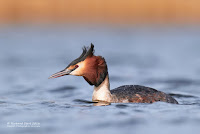



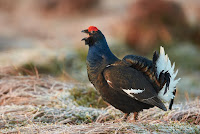


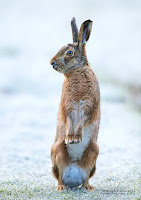
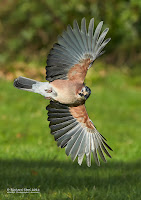

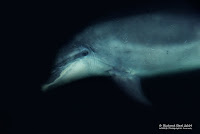
1 comment:
The Eiders are superbly exposed and I think the Seal looks rather good!
Post a Comment